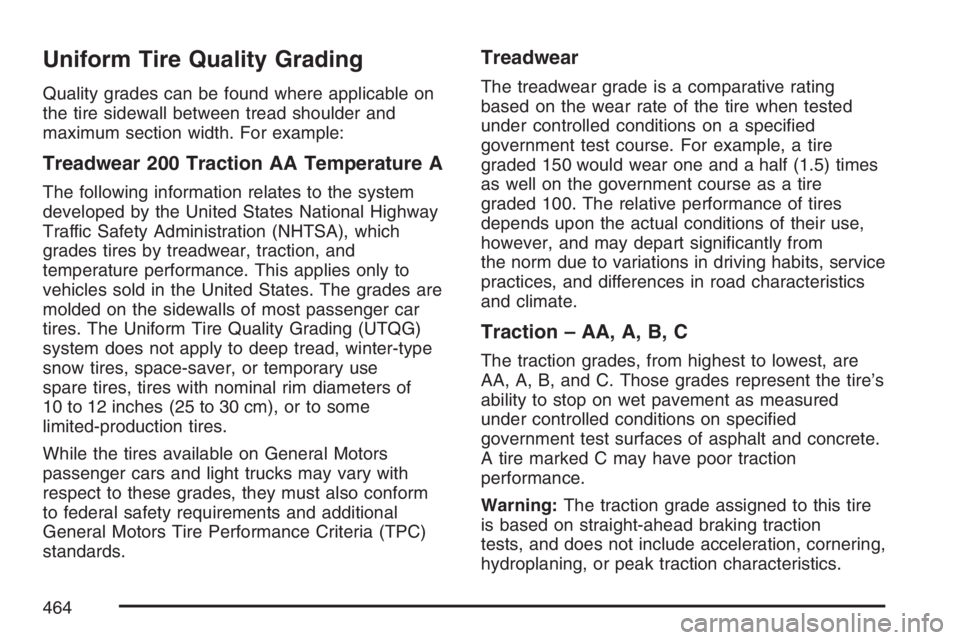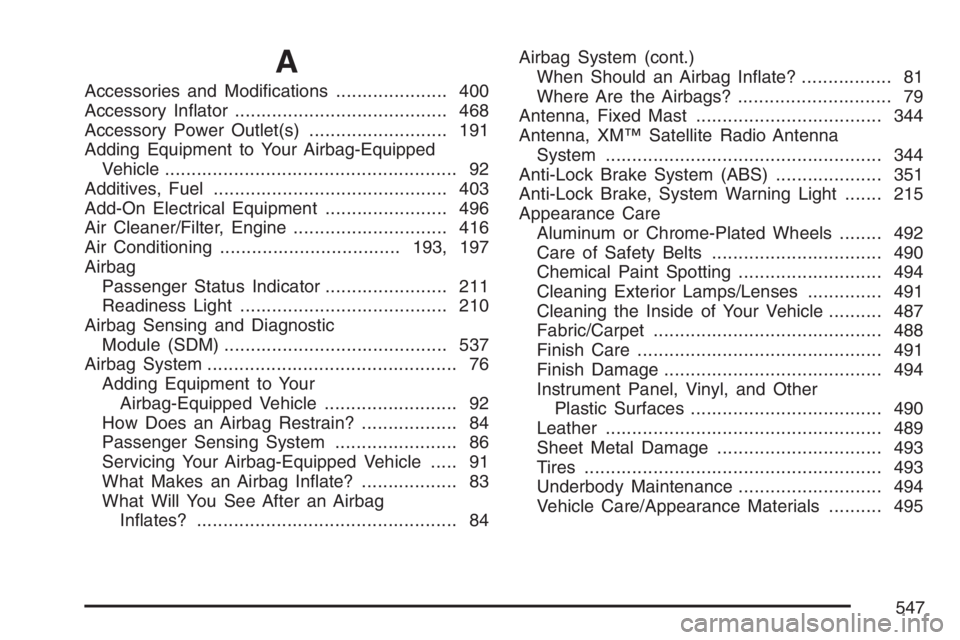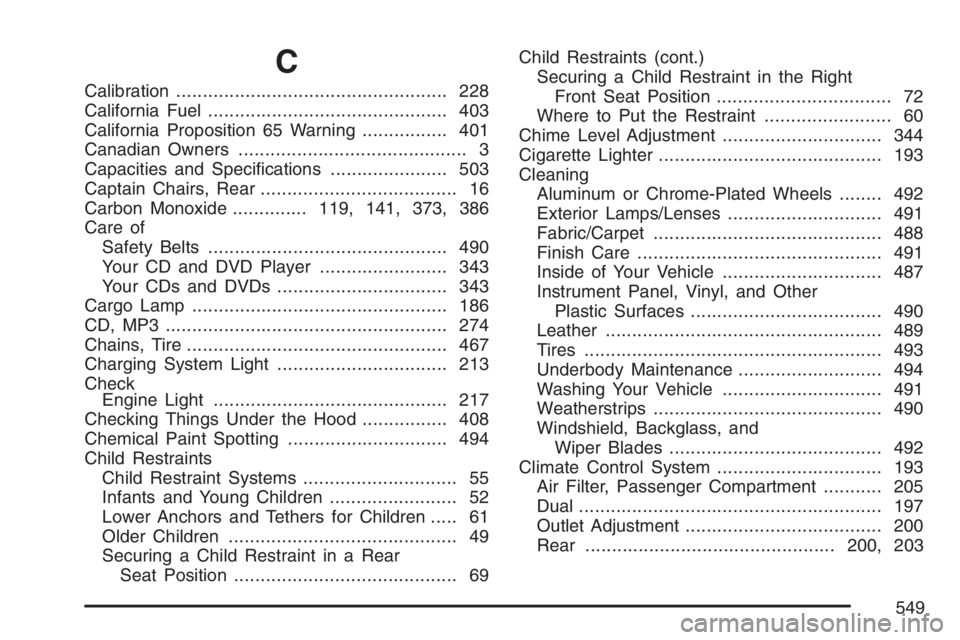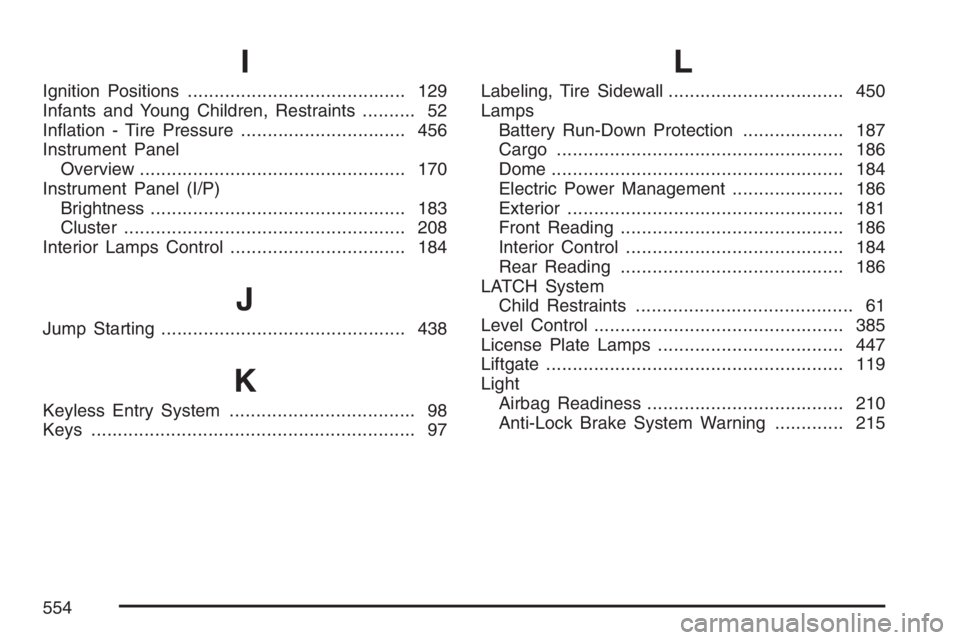warning light BUICK TERRAZA 2007 Owner's Guide
[x] Cancel search | Manufacturer: BUICK, Model Year: 2007, Model line: TERRAZA, Model: BUICK TERRAZA 2007Pages: 562, PDF Size: 2.96 MB
Page 436 of 562

Brake Wear
Your vehicle has four-wheel disc brakes.
Disc brake pads have built-in wear indicators that
make a high-pitched warning sound when the
brake pads are worn and new pads are needed.
The sound may come and go or be heard all
the time your vehicle is moving, except when you
are pushing on the brake pedal �rmly.
{CAUTION:
The brake wear warning sound means that
soon your brakes will not work well. That
could lead to an accident. When you hear
the brake wear warning sound, have your
vehicle serviced.
Notice:Continuing to drive with worn-out
brake pads could result in costly brake repair.Some driving conditions or climates may cause a
brake squeal when the brakes are �rst applied
or lightly applied. This does not mean something
is wrong with your brakes.
Properly torqued wheel nuts are necessary to help
prevent brake pulsation. When tires are rotated,
inspect brake pads for wear and evenly tighten
wheel nuts in the proper sequence to GM torque
speci�cations.
Brake linings should always be replaced as
complete axle sets.
Brake Pedal Travel
See your dealer if the brake pedal does not return
to normal height, or if there is a rapid increase
in pedal travel. This could be a sign of brake
trouble.
Brake Adjustment
Every time you apply the brakes, with or without
the vehicle moving, your brakes adjust for wear.
436
Page 464 of 562

Uniform Tire Quality Grading
Quality grades can be found where applicable on
the tire sidewall between tread shoulder and
maximum section width. For example:
Treadwear 200 Traction AA Temperature A
The following information relates to the system
developed by the United States National Highway
Traffic Safety Administration (NHTSA), which
grades tires by treadwear, traction, and
temperature performance. This applies only to
vehicles sold in the United States. The grades are
molded on the sidewalls of most passenger car
tires. The Uniform Tire Quality Grading (UTQG)
system does not apply to deep tread, winter-type
snow tires, space-saver, or temporary use
spare tires, tires with nominal rim diameters of
10 to 12 inches (25 to 30 cm), or to some
limited-production tires.
While the tires available on General Motors
passenger cars and light trucks may vary with
respect to these grades, they must also conform
to federal safety requirements and additional
General Motors Tire Performance Criteria (TPC)
standards.
Treadwear
The treadwear grade is a comparative rating
based on the wear rate of the tire when tested
under controlled conditions on a speci�ed
government test course. For example, a tire
graded 150 would wear one and a half (1.5) times
as well on the government course as a tire
graded 100. The relative performance of tires
depends upon the actual conditions of their use,
however, and may depart signi�cantly from
the norm due to variations in driving habits, service
practices, and differences in road characteristics
and climate.
Traction – AA, A, B, C
The traction grades, from highest to lowest, are
AA, A, B, and C. Those grades represent the tire’s
ability to stop on wet pavement as measured
under controlled conditions on speci�ed
government test surfaces of asphalt and concrete.
A tire marked C may have poor traction
performance.
Warning:The traction grade assigned to this tire
is based on straight-ahead braking traction
tests, and does not include acceleration, cornering,
hydroplaning, or peak traction characteristics.
464
Page 547 of 562

A
Accessories and Modi�cations..................... 400
Accessory In�ator........................................ 468
Accessory Power Outlet(s).......................... 191
Adding Equipment to Your Airbag-Equipped
Vehicle....................................................... 92
Additives, Fuel............................................ 403
Add-On Electrical Equipment....................... 496
Air Cleaner/Filter, Engine............................. 416
Air Conditioning..................................193, 197
Airbag
Passenger Status Indicator....................... 211
Readiness Light....................................... 210
Airbag Sensing and Diagnostic
Module (SDM).......................................... 537
Airbag System............................................... 76
Adding Equipment to Your
Airbag-Equipped Vehicle......................... 92
How Does an Airbag Restrain?.................. 84
Passenger Sensing System....................... 86
Servicing Your Airbag-Equipped Vehicle..... 91
What Makes an Airbag In�ate?.................. 83
What Will You See After an Airbag
In�ates?................................................. 84Airbag System (cont.)
When Should an Airbag In�ate?................. 81
Where Are the Airbags?............................. 79
Antenna, Fixed Mast................................... 344
Antenna, XM™ Satellite Radio Antenna
System.................................................... 344
Anti-Lock Brake System (ABS).................... 351
Anti-Lock Brake, System Warning Light....... 215
Appearance Care
Aluminum or Chrome-Plated Wheels........ 492
Care of Safety Belts................................ 490
Chemical Paint Spotting........................... 494
Cleaning Exterior Lamps/Lenses.............. 491
Cleaning the Inside of Your Vehicle.......... 487
Fabric/Carpet........................................... 488
Finish Care.............................................. 491
Finish Damage......................................... 494
Instrument Panel, Vinyl, and Other
Plastic Surfaces.................................... 490
Leather.................................................... 489
Sheet Metal Damage............................... 493
Tires........................................................ 493
Underbody Maintenance........................... 494
Vehicle Care/Appearance Materials.......... 495
547
Page 548 of 562

Appearance Care (cont.)
Washing Your Vehicle.............................. 491
Weatherstrips........................................... 490
Windshield, Backglass, and
Wiper Blades........................................ 492
Audio System(s).......................................... 258
Audio Steering Wheel Controls................. 341
Care of Your CD and DVD Player............ 343
Care of Your CDs and DVDs................... 343
Chime Level Adjustment........................... 344
Fixed Mast Antenna................................. 344
Mobile Digital Media System.................... 319
Navigation/Radio System,
see Navigation Manual......................... 282
Radio with CD......................................... 260
Rear Seat Audio (RSA)...................314, 316
Setting the Time...................................... 259
Theft-Deterrent Feature............................ 340
Understanding Radio Reception............... 342
XM™ Satellite Radio Antenna System...... 344
Automatic Door Lock................................... 109
Automatic Transaxle
Fluid........................................................ 417
Operation................................................. 133B
Battery........................................................ 437
Electric Power Management..................... 186
Run-Down Protection............................... 187
Before Leaving on a Long Trip.................... 370
Brake
Anti-Lock Brake System (ABS)................. 351
Emergencies............................................ 353
Parking.................................................... 137
System Warning Light.............................. 214
Brakes........................................................ 434
Braking....................................................... 350
Braking in Emergencies............................... 353
Break-In, New Vehicle................................. 128
Bulb Replacement....................................... 443
Front Turn Signal, Parking and
Daytime Running Lamps....................... 445
Halogen Bulbs......................................... 443
License Plate Lamps................................ 447
Replacement Bulbs.................................. 447
Taillamps, Turn Signal, Stoplamps and
Back-up Lamps..................................... 445
Buying New Tires........................................ 461
548
Page 549 of 562

C
Calibration................................................... 228
California Fuel............................................. 403
California Proposition 65 Warning................ 401
Canadian Owners........................................... 3
Capacities and Speci�cations...................... 503
Captain Chairs, Rear..................................... 16
Carbon Monoxide..............119, 141, 373, 386
Care of
Safety Belts............................................. 490
Your CD and DVD Player........................ 343
Your CDs and DVDs................................ 343
Cargo Lamp................................................ 186
CD, MP3 ..................................................... 274
Chains, Tire................................................. 467
Charging System Light................................ 213
Check
Engine Light............................................ 217
Checking Things Under the Hood................ 408
Chemical Paint Spotting.............................. 494
Child Restraints
Child Restraint Systems............................. 55
Infants and Young Children........................ 52
Lower Anchors and Tethers for Children..... 61
Older Children........................................... 49
Securing a Child Restraint in a Rear
Seat Position.......................................... 69Child Restraints (cont.)
Securing a Child Restraint in the Right
Front Seat Position................................. 72
Where to Put the Restraint........................ 60
Chime Level Adjustment .............................. 344
Cigarette Lighter.......................................... 193
Cleaning
Aluminum or Chrome-Plated Wheels........ 492
Exterior Lamps/Lenses............................. 491
Fabric/Carpet........................................... 488
Finish Care.............................................. 491
Inside of Your Vehicle .............................. 487
Instrument Panel, Vinyl, and Other
Plastic Surfaces.................................... 490
Leather.................................................... 489
Tires........................................................ 493
Underbody Maintenance........................... 494
Washing Your Vehicle .............................. 491
Weatherstrips........................................... 490
Windshield, Backglass, and
Wiper Blades........................................ 492
Climate Control System............................... 193
Air Filter, Passenger Compartment........... 205
Dual......................................................... 197
Outlet Adjustment..................................... 200
Rear...............................................200, 203
549
Page 551 of 562

Driver
Position, Safety Belt................................... 31
Driver Information Center (DIC)................... 223
DIC Operation and Displays..................... 224
DIC Vehicle Personalization..................... 249
DIC Warnings and Messages................... 230
Driving
At Night................................................... 363
City.......................................................... 368
Defensive................................................. 346
Drunken................................................... 347
Freeway................................................... 369
Hill and Mountain Roads.......................... 371
In Rain and on Wet Roads...................... 365
Rocking Your Vehicle to Get it Out.......... 378
Winter...................................................... 373
Dual Climate Control System....................... 197
DVD
Rear Seat Entertainment System.....282, 298E
Electric Power Management........................ 186
Electrical System
Add-On Equipment................................... 496
Fuses and Circuit Breakers...................... 497
Headlamp Wiring..................................... 497
Instrument Panel Fuse Block................... 498
Power Windows and Other Power
Options................................................. 497
Underhood Fuse Block............................. 500
Windshield Wiper Fuses........................... 497
Engine
Air Cleaner/Filter...................................... 416
Battery..................................................... 437
Check and Service Engine Soon Light..... 217
Coolant.................................................... 420
Coolant Heater......................................... 132
Coolant Temperature Gage...................... 217
551
Page 552 of 562

Engine (cont.)
Drive Belt Routing.................................... 521
Engine Compartment Overview................ 410
Exhaust................................................... 141
Oil ........................................................... 411
Oil Life System........................................ 414
Overheated Protection Operating Mode...... 425
Overheating............................................. 423
Starting.................................................... 130
Entry Lighting.............................................. 184
Event Data Recorders (EDR)...................... 537
Exit Lighting................................................ 185
Extender, Safety Belt..................................... 48
Exterior Lamps............................................ 181
F
Filter
Engine Air Cleaner................................... 416
Finish Damage............................................ 494
Fixed Mast Antenna.................................... 344
Flashers, Hazard Warning........................... 172
Flash-to-Pass.............................................. 174
Flat Tire...................................................... 470
Flat Tire, Changing...................................... 470Flat Tire, Storing......................................... 483
Fluid
Automatic Transaxle................................. 417
Power Steering........................................ 432
Windshield Washer.................................. 433
Folding Tray................................................ 161
Front Console Storage Area........................ 161
Front Reading Lamps.................................. 186
Front Turn Signal, Parking and
Daytime Running Lamps.......................... 445
Fuel............................................................ 402
Additives.................................................. 403
California Fuel.......................................... 403
Filling a Portable Fuel Container.............. 407
Filling Your Tank...................................... 405
Fuels in Foreign Countries....................... 404
Gage....................................................... 222
Gasoline Octane...................................... 402
Gasoline Speci�cations............................ 402
Low Warning Light................................... 222
Fuses
Fuses and Circuit Breakers...................... 497
Instrument Panel Fuse Block................... 498
Underhood Fuse Block............................. 500
Windshield Wiper..................................... 497
552
Page 553 of 562

G
Gage
Engine Coolant Temperature.................... 217
Fuel......................................................... 222
Speedometer........................................... 209
Tachometer.............................................. 209
Garage Door Opener..........................147, 148
Gasoline
Octane..................................................... 402
Speci�cations........................................... 402
Glove Box................................................... 158
GM Mobility Reimbursement Program.......... 531
H
Hazard Warning Flashers............................ 172
Head Restraints............................................ 15
Headlamp Wiring......................................... 497
Headlamps
Bulb Replacement.................................... 443
Daytime Running Lamps/Automatic
Headlamp System................................ 182Headlamps (cont.)
Flash-to-Pass........................................... 174
Halogen Bulbs......................................... 443
Headlamps and Sidemarker Lamps.......... 443
High/Low Beam Changer......................... 174
On Reminder........................................... 182
Wiper Activated........................................ 182
Headlamps and Sidemarker Lamps............. 443
Heated Seats................................................ 10
Heater................................................193, 197
Highbeam On Light..................................... 221
High-Speed Operation, Tires........................ 458
Highway Hypnosis....................................... 371
Hill and Mountain Roads............................. 371
Hood
Checking Things Under............................ 408
Release................................................... 409
Horn............................................................ 172
How to Use This Manual ................................ 4
How to Wear Safety Belts Properly............... 31
553
Page 554 of 562

I
Ignition Positions......................................... 129
Infants and Young Children, Restraints.......... 52
In�ation - Tire Pressure............................... 456
Instrument Panel
Overview.................................................. 170
Instrument Panel (I/P)
Brightness................................................ 183
Cluster..................................................... 208
Interior Lamps Control................................. 184
J
Jump Starting.............................................. 438
K
Keyless Entry System................................... 98
Keys............................................................. 97
L
Labeling, Tire Sidewall................................. 450
Lamps
Battery Run-Down Protection................... 187
Cargo...................................................... 186
Dome....................................................... 184
Electric Power Management..................... 186
Exterior.................................................... 181
Front Reading.......................................... 186
Interior Control......................................... 184
Rear Reading.......................................... 186
LATCH System
Child Restraints......................................... 61
Level Control............................................... 385
License Plate Lamps................................... 447
Liftgate........................................................ 119
Light
Airbag Readiness..................................... 210
Anti-Lock Brake System Warning............. 215
554
Page 555 of 562

Light (cont.)
Brake System Warning............................. 214
Charging System..................................... 213
Cruise Control.......................................... 221
Highbeam On.......................................... 221
Low Fuel Warning.................................... 222
Malfunction Indicator................................ 217
Oil Pressure............................................. 220
Passenger Airbag Status Indicator............ 211
Passenger Safety Belt Reminder.............. 210
Safety Belt Reminder............................... 209
Security................................................... 221
TCS Warning Light.................................. 216
Traction Control System (TCS) Warning..... 216
Lighting
Delayed................................................... 185
Entry........................................................ 184
Exit.......................................................... 185
Loading Your Vehicle................................... 378
Lockout Protection....................................... 109
Locks
Automatic Door Lock................................ 109
Delayed Locking...................................... 108
Door........................................................ 106
Lockout Protection................................... 109Locks (cont.)
Power Door............................................. 107
Programmable Automatic Door Unlock..... 109
Loss of Control........................................... 362
Low Fuel Warning Light............................... 222
Luggage Carrier.......................................... 162
M
Maintenance Schedule
Additional Required Services.................... 512
At Each Fuel Fill...................................... 515
At Least Once a Month............................ 515
At Least Once a Year .............................. 516
Introduction.............................................. 506
Maintenance Footnotes............................ 513
Maintenance Record................................ 522
Maintenance Requirements...................... 506
Normal Maintenance Replacement Parts.... 520
Owner Checks and Services.................... 514
Recommended Fluids and Lubricants....... 518
Scheduled Maintenance........................... 509
Using....................................................... 507
Your Vehicle and the Environment............ 506
Malfunction Indicator Light........................... 217
555